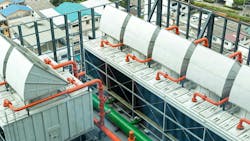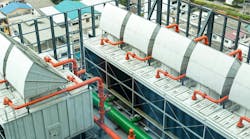Direct Liquid Cooling Tames High-Density Data Center Heat
What you'll learn:
- Why cooling is critical to data center system design.
- What types of cooling options are available to designers?
- Advantages and disadvantages of single-phase immersion cooling.
Liquid cooling is rapidly becoming essential as a solution to handle data center thermal issues, since efforts will soon be needed to balance high-performance computing (HPC) and artificial-intelligence (AI) demands with local electrical power supplies. Different kinds of liquid-cooling technologies are available, such as immersion and direct-to-chip, yet many myths still persist about liquid cooling.
Today, most present electrical power supplies will not be able to meet this demand in the long-term future.
Just one graphics processing unit (GPU), on average, will consume 54 kWh/day, which is typically the equivalent of two residential homes. However, when extrapolating that to 5,000 data center racks (300,000 GPUs), it’s approximately the amount of energy that can power 400,000 homes, similar to the size of Austin, Texas.
If the system isn’t able to adequately cool to achieve its maximum computational level, which will usually average below 75% of capacity, it will lead to taxing legacy data centers' HVAC air-conditioning equipment. Simulation can help optimize the design of a data center cooling system.
Liquid-Cooling Solutions in the Data Center
Multiple technologies, from various organizations, are necessary to successfully drive liquid-cooling solutions. It’s best to install these systems sequentially together, leading to the creation of a sustainable data center. However, it may be tough to find a solid turnkey provider that’s fully able to specify, plan, coordinate, and manage projects, as well as install all of the various technologies on site, for a seamless startup.
When the system is installed, maintenance may be somewhat complicated for the end user. Though the adoption of liquid-cooled solutions is ramping up, most data center technicians haven’t received adequate training to properly employ liquid-cooled hardware and the necessary component maintenance techniques.
Designers must clearly define their objectives and goals before evaluating liquid-cooling solutions. The next step should involve devising a plan for a detailed audit of the data center project, along with its existing or targeted new equipment. This will help scope equipment and site requirements.
>>Download the PDF of this article, and check out the Series Library for similar articles and videos
Afterward, prepare to present your objectives and identify the optimal single-source provider that’s non-OEM biased and well-versed in multiple liquid-cooling technologies.
A single-source partner must be capable of leading initial specifications and scoping efforts, procuring the user's target technology. In addition, it must deliver on-site project management and installation, installing and commissioning the user's servers, and offering full lifecycle maintenance on the new system. If designers are evaluating multiple solution providers, they need to remember to request a total cost of ownership summary from each of these providers for a true, solid comparison.
Rear Door Heat Exchanger (RDHX)
Liquid-cooling technologies will provide a solid, wide range of use cases and ranges, along with installation complexities. One of the most common technologies is the RDHX “Rear Door Heat Exchanger.” This technology presents the least intrusive liquid-cooling solution and is able to retrofit existing rack systems.
Direct-to-Chip Cooling
Direct-to-chip (DTC) cooling, also known as cold-plate liquid cooling or direct liquid cooling (DLC), involves cooling servers by circulating heat directly to their components. DTC can be more complicated for installers, but it will deliver higher cooling efficiency and a higher rack density.
Single-Phase Immersion Cooling
A third option is full liquid immersion, also known as single-phase immersion cooling. Full immersion is the far most complex installation, but it offers significant advantages over RDHX and DTC such as maximum cooling efficiency and computational performance. Full liquid immersion will also significantly reduce data center HVAC air-conditioning requirements, while lowering noise decibel levels for data center staff.
This method, also known as open-bath immersion cooling, submerges servers or electronic components in a thermally and non-conductive liquid dielectric that acts as a coolant, thereby preventing electrical discharge. The non-conductive liquid dielectric fluid will be able to absorb heat from the components. Because this method is single-phase, it will remain in liquid form throughout the entire process.
A dielectric coolant is a medium that can transmit an electric force but doesn’t involve conduction. Some examples of dielectric cooling are mineral oil or a deionized water system.
The coolant fluid will come in contact with the heated hardware, which is immersed in the bath. The heated hardware will raise the temperature of the fluid using conduction. When heated, the fluid is pumped to a heat exchanger. The heat exchanger cools the liquid and will be transferred back to the open tank. One type of heat exchanger is a cooling tower.
Single-phase systems are lower cost to maintain, have lower coolant costs, and have fewer issues with vapors and coolant evaporation.
Advantages and Disadvantages of Single-Phase Immersion Cooling
Advantages of single-phase immersion cooling include:
- High heat dissipation: The method can handle high heat loads because the liquid has a high heat capacity and efficiently transfers heat away from the components.
- Uniform cooling: The entire component will be cooled uniformly because the dielectric fluid will directly touch and surround the immersed components.
- Noise reduction: Since no fans or any other air-moving methods are needed, noise levels will be significantly reduced.
- Reduced cooling infrastructure: Because the system doesn’t rely on air circulation, there’s no need for fans, air-conditioning units, or any large cooling infrastructure.
- Environmental control: Immersion-cooling systems are relatively isolated from environmental factors, such as humidity and dust, which can be beneficial in harsh environments.
Disadvantages of this cooling method are:
- Initial setup cost: The immersion-cooling infrastructure may be costly, especially when retrofitting any existing data centers.
- Fluid management: The management and choice of the dielectric fluid are crucial, possibly leading to high cost. The long-term compatibility and stability of materials have to be ensured.
- Maintenance and accessibility: Maintenance can be challenging because components must be removed from the fluid when servicing or replacement is needed.
References
1. “Hybrid for the Win: Optimizing Liquid Cooling Solutions Using Existing Air-Cooling Data Center Infrastructure,” Data Center Frontier, May 5, 2025.
2. “Direct Liquid Cooling: The new gold standard for data centers,” Computacenter.
3. “Liquid Cooling Options for Data Centers,” Vertiv.
4. “Flex acquires JetCool to boost data center cooling tech,” Investing.com, November 14, 2024
5. “AI runs hot. We keep it cool at scale,” JetCool, a Flex Company.
6. “How to Mitigate the Complexities of Installing and Maintaining Liquid Cooled Data Centers,” Chris Carreiro, Chief Technology Officer at Park Place Technologies, Data Center Frontier, June 2, 2025.
7. “Access Control Systems in Data Centers: Choosing The Right System For Optimal Security,” Databank, June 23, 2024.
>>Download the PDF of this article, and check out the Series Library for similar articles and videos
About the Author

Steve Taranovich
Freelance Technical Writer, Phoenix Information Communication LLC
Steve is a contributing editor to Electronic Design.
Author of the non-fiction “Guardians of the Right Stuff,” a true story of the Apollo program as told by NASA and Grumman Corp. engineers, an astronaut, and technicians.
Experienced Editor-In-Chief of EETimes/Planet Analog and Senior Technical Editor at EDN running the Analog and Power Management Design Centers from 2012 to 2019.
A demonstrated history in electronic circuit design and applications for 40 years, and nine years of technical writing and editing in industry. Skilled in Analog Electronics, Space-related Electronics, Audio, RF & Communications, Power Management, Electrical Engineering, and Integrated Circuits (IC).
1972 to 1988 worked as a circuit design engineer in audio (8 years) and microwave (8 years). Then was Corporate Account Manager/applications engineer for Burr-Brown from 1988 to 2000 when TI purchased Burr-Brown. Worked for TI from 2000 to 2011.
Strong media and communication professional with a BEEE from NYU Engineering in 1972 and an MSEE from Polytechnic University in 1989. Senior Lifetime member of IEEE. Former IEEE Long Island, NY Director of Educational Activities. Eta Kappa Nu EE honor society member since 1970.


